Forecast of Coal Demand in Shanxi Province Based on GA—LSSVM under Multiple Scenarios
Abstract
:1. Introduction
2. Predictive Model Building
2.1. Least Squares Support Vector Machine
2.2. GA–LSSVM Model Construction
- (1)
- Set the initial values for random training and the parameters of the LSSVM model. Select training and testing samples, and set the penalty factor and radial basis kernel function parameters .
- (2)
- The initial population is randomly generated, and the solution vector is genetically encoded. Determine the population size , crossover probability , mutation probability , and termination evolution criterion; randomly generate individuals as the initial population.
- (3)
- Calculate individual fitness. Calculate the fitness of each individual and define the fitness function:Among them, is the actual value of the i-th sample, and is the predicted value of the i-th sample.
- (4)
- Population evolution, including the selection of mothers, crossover, mutation, and selection of progeny to generate a new generation of populations that are more adapted to the environment.
- (5)
- Check the termination condition. By comparing the adaptive values of each gene, the optimal fitness is obtained, and the value of the output penalty factor and radial basis kernel function parameter is the optimal solution (otherwise, proceed to step 3).
- (6)
- Build the GA–LSSVM model [30]. Through training, the optimal parameters and of LSSVM are obtained, which are brought into the LSSVM prediction model to obtain the GA–LSSVM prediction model.
2.3. Scenario Prediction Model Based on GA–LSSVM
3. Index and Model Analysis
3.1. Index Analysis
3.1.1. Index Selection
3.1.2. Data Sources
3.2. Predictive Model Suitability Analysis
4. Empirical Research
4.1. Conventional Scenario Trend Extrapolation
4.2. Multiple Scenario Settings
4.2.1. Economic Variables
4.2.2. Environment Variables
4.3. Coal Demand Forecast
5. Conclusions and Suggestions
5.1. Conclusions
- (1)
- Six factors, such as GDP, population, urbanization ratio, electricity consumption in the whole society, thermal power installed capacity, and carbon emissions, have a strong correlation with the demand for thermal coal, among which GDP, population, urbanization ratio, and the electricity consumption of the whole society are economic-related variables, and the installed thermal power capacity and carbon emissions are environmental-related variables.
- (2)
- After analyzing the constructed GA–LSSVM thermal coal demand prediction model, it is found that the error of the modified model is small, and the calculation simple, giving high convergence accuracy, less subjective impact, and objective results; the algorithm has superiority in predicting thermal coal demand.
- (3)
- The thermal coal demand in Shanxi Province shows a trend of increasing first and then decreasing. Under the mode of high-speed economic development and low emission reduction, Shanxi Province has the largest demand for thermal coal, and under the mode of low-speed economic development and strong emission reduction, Shanxi Province has the lowest demand for thermal coal. Economic development is positively correlated with the demand for thermal coal, and carbon emission reduction efforts are negatively correlated with the demand for thermal coal. The combined effect of restrictions on the scale of economic development and the implementation of carbon emission reduction measures will keep the demand for thermal coal at a low level.
5.2. Suggestions
- (1)
- Coordinate economic and low-carbon development. At the same time of rapid economic development, we must adhere to the concept of green and low-carbon development, reasonably encourage the development of environmental protection and green industries, optimize the industrial structure and high-polluting industrial structure, improve the efficiency of coal use, and increase the role of low-emission industries in the national economy proportion.
- (2)
- Promote upgrading and transformation and accelerate the transformation of coal-fired power. As a national energy and heavy chemical industry base, Shanxi Province has made great contributions to the development of the country. Shanxi Province should promote the standardization of green coal mining, and further enhance the support and guarantee capacity of coal. At the same time, it is necessary to vigorously promote the implementation of measures such as energy-saving and carbon reduction transformation, flexibility transformation, and heating transformation of coal-fired power units.
- (3)
- Optimize the power generation structure and promote the utilization of clean energy. Under the “dual carbon goals”, Shanxi Province should adhere to the concept of green development, optimize and adjust the energy consumption structure of power generation, and promote the green and efficient development and utilization of non-renewable energy. At the same time, it is necessary to flexibly use the power market mechanism, further play the coordinating role of the carbon trading market, promote the use of renewable and clean energy, insist on the substitution of electric energy, and make energy consumption more diversified.
Author Contributions
Funding
Institutional Review Board Statement
Informed Consent Statement
Data Availability Statement
Acknowledgments
Conflicts of Interest
References
- Huo, T.; Cao, R.; Du, H.; Zhang, J.; Liu, B. Nonlinear influence of urbanization on China’s urban residential building carbon emissions: New evidence from panel threshold model. Sci. Total Environ. 2021, 772, 145058. [Google Scholar] [CrossRef] [PubMed]
- Mengshu, S.; Yuansheng, H.; Xiaofeng, X.; Dunnan, L. China’s coal consumption forecasting using adaptive differential evolution algorithm and support vector machine. Resour. Policy 2021, 74, 102287. [Google Scholar] [CrossRef]
- Hao, Y.; Zhang, Z.-Y.; Liao, H.; Wei, Y.-M. China’s farewell to coal: A forecast of coal consumption through 2020. Energy Policy 2015, 86, 444–455. [Google Scholar] [CrossRef]
- Yan, W.; Jingwen, L. China’s Present Situation of Coal Consumption and Future Coal Demand Forecast. China Popul. Resour. Environ. 2008, 18, 152–155. [Google Scholar] [CrossRef]
- Wang, J.; Dong, Y.; Wu, J.; Mu, R.; Jiang, H. Coal production forecast and low carbon policies in China. Energy Policy 2011, 39, 5970–5979. [Google Scholar] [CrossRef]
- Li, Y.; Li, Z. Forecasting of Coal Demand in China Based on Support Vector Machine Optimized by the Improved Gravitational Search Algorithm. Energies 2019, 12, 2249. [Google Scholar] [CrossRef]
- Wang, B.; Wang, L.M.; Zhong, S.; Xiang, N.; Qu, Q.S. Low-Carbon Transformation of Electric System against Power Shortage in China: Policy Optimization. Energies 2022, 15, 1574. [Google Scholar] [CrossRef]
- Chen, H.; Wang, J.; Tang, B.; Xiao, K.; Li, J. An integrated approach to planetary gearbox fault diagnosis using deep belief networks. Meas. Sci. Technol. 2017, 28, 025010. [Google Scholar] [CrossRef]
- Felling, T. Development of a genetic algorithm and its application to a bi-level problem of system cost optimal electricity price zone configurations. Energy Econ. 2021, 101, 105422. [Google Scholar] [CrossRef]
- Teng, M.; Burke, P.J.; Liao, H. The demand for coal among China’s rural households: Estimates of price and income elasticities. Energy Econ. 2019, 80, 928–936. [Google Scholar] [CrossRef]
- Zhao, Z.-Y.; Zhu, J.; Xia, B. Multi-fractal fluctuation features of thermal power coal price in China. Energy 2016, 117, 10–18. [Google Scholar] [CrossRef]
- Yu, S.W.; Zhu, K.J. A hybrid procedure for energy demand forecasting in China. Energy 2012, 37, 396–404. [Google Scholar] [CrossRef]
- Yu, S.; Wei, Y.M.; Wang, K. China’s primary energy demands in 2020: Predictions from an MPSO-RBF estimation model. Energy Convers. Manag. 2012, 61, 59–66. [Google Scholar] [CrossRef]
- Uenler, A. Improvement of energy demand forecasts using swarm intelligence: The case of Turkey with projections to 2025. Energy Policy 2008, 36, 1937–1944. [Google Scholar] [CrossRef]
- Kourentzes, N. Intermittent demand forecasts with neural networks. Int. J. Prod. Econ. 2013, 143, 198–206. [Google Scholar] [CrossRef]
- Crompton, P.; Wu, Y. Energy consumption in China: Past trends and future directions. Energy Econ. 2005, 27, 195–208. [Google Scholar] [CrossRef]
- Mirjat, N.H.; Uqaili, M.A.; Harijan, K.; Walasai, G.D.; Mondal, M.; Sahin, H. Long-Term Electricity Demand Forecast and Supply Side Scenarios for Pakistan (2015-2050): A LEAP Model Application for Policy Analysis. Energy 2018, 165, 512–526. [Google Scholar] [CrossRef]
- Fayin, Z. Thermal Coal Demand Forecasting Model and Empirical Research Based on Improved X-12-ARIMA. Electr. Power 2014, 47, 140–145. [Google Scholar]
- He, Y.; Jinping, L.; Rui, N. Research on Necessity and Feasibility for Emergency Reserve of Electric Coal in China. Econ. Probl. 2012, 2, 66–69. [Google Scholar]
- Mar, A.; Klk, A.; Ai, B.; Miuh, B.; Ma, B.; Kr, C.; Ass, D. Energy demand and production forecasting in Pakistan. Energy Strategy Rev. 2022, 39, 100788. [Google Scholar]
- Li, H.; Zhang, R.; Mahmud, M.A.; Hredzak, B. A novel coordinated optimization strategy for high utilization of renewable energy sources and reduction of coal costs and emissions in hybrid hydro-thermal-wind power systems. Appl. Energy 2022, 320, 119019. [Google Scholar] [CrossRef]
- Alameer, Z.; Fathalla, A.; Li, K.; Ye, H.; Jianhua, Z. Multistep-ahead forecasting of coal prices using a hybrid deep learning model. Resour. Policy 2020, 65, 101588. [Google Scholar] [CrossRef]
- Bao-De, L.; Xin-Yang, Z.; Mei, Z.; Hui, L.; Guang-Qian, L. Improved genetic algorithm-based research on optimization of least square support vector machines: An application of load forecasting. Soft Comput. 2021, 25, 11997–12005. [Google Scholar] [CrossRef]
- Kalteh, A.M. Improving Forecasting Accuracy of Streamflow Time Series Using Least Squares Support Vector Machine Coupled with Data-Preprocessing Techniques. Water Resour. Manag. 2016, 30, 747–766. [Google Scholar] [CrossRef]
- Kaytez, F.; Taplamacioglu, M.C.; Cam, E.; Hardalac, F. Forecasting electricity consumption: A comparison of regression analysis, neural networks and least squares support vector machines. Int. J. Electr. Power Energy Syst. 2015, 67, 431–438. [Google Scholar] [CrossRef]
- Jung, H.C.; Kim, J.S.; Heo, H. Prediction of building energy consumption using an improved real coded genetic algorithm based least squares support vector machine approach. Energy Build. 2015, 90, 76–84. [Google Scholar] [CrossRef]
- Lee, C.-W.; Lin, B.-Y. Applications of the Chaotic Quantum Genetic Algorithm with Support Vector Regression in Load Forecasting. Energies 2017, 10, 1832. [Google Scholar] [CrossRef]
- Pan, X.; Xing, Z.; Tian, C.; Wang, H.; Liu, H. A method based on GA-LSSVM for COP prediction and load regulation in the water chiller system. Energy Build. 2021, 230, 110604. [Google Scholar] [CrossRef]
- Wang, J.; Hu, J. A robust combination approach for short-term wind speed forecasting and analysis—Combination of the ARIMA (Autoregressive Integrated Moving Average), ELM (Extreme Learning Machine), SVM (Support Vector Machine) and LSSVM (Least Square SVM) forecasts using a GPR (Gaussian Process Regression) model. Energy 2015, 93, 41–56. [Google Scholar]
- Pai, P.F.; Hong, W.C. Forecasting regional electricity load based on recurrent support vector machines with genetic algorithms. Electr. Power Syst. Res. 2005, 74, 417–425. [Google Scholar] [CrossRef]
- Kante, M.; Li, Y.; Deng, S. Scenarios Analysis on Electric Power Planning Based on Multi-Scale Forecast: A Case Study of Taoussa, Mali from 2020 to 2035. Energies 2021, 14, 8515. [Google Scholar] [CrossRef]
- Li, H.; Ren, Z.; Fan, M.; Li, W.; Xu, Y.; Jiang, Y.; Xia, W. A review of scenario analysis methods in planning and operation of modern power systems: Methodologies, applications, and challenges. Electr. Power Syst. Res. 2022, 205, 107722. [Google Scholar] [CrossRef]
- Wang, X.; Liu, X.; Jian, S.; Peng, X.; Yuan, H. A distribution network reconfiguration method based on comprehensive analysis of operation scenarios in the long-term time period. Energy Rep. 2021, 7, 369–379. [Google Scholar] [CrossRef]
- Pinto, T.; Praca, I.; Vale, Z.; Morais, H.; Sousa, T.M. Strategic bidding in electricity markets: An agent-based simulator with game theory for scenario analysis. Integr. Comput. Aided Eng. 2013, 20, 335–346. [Google Scholar] [CrossRef] [Green Version]
- Song, Z.; Niu, D.; Dai, S.; Xiao, X.; Wang, Y. Incorporating the influence of China’s industrial capacity elimination policies in electricity demand forecasting. Util. Policy 2017, 47, 1–11. [Google Scholar] [CrossRef]
- Cai, L.; Duan, J.; Lu, X.; Luo, J.; Yi, B.; Wang, Y.; Jin, D.; Lu, Y.; Qiu, L.; Chen, S.; et al. Pathways for electric power industry to achieve carbon emissions peak and carbon neutrality based on LEAP model: A case study of state-owned power generation enterprise in China. Comput. Ind. Eng. 2022, 170, 108334. [Google Scholar] [CrossRef]
- Wei, Y.-M.; Chen, K.; Kang, J.-N.; Chen, W.; Wang, X.-Y.; Zhang, X. Policy and Management of Carbon Peaking and Carbon Neutrality: A Literature Review. Engineering 2022, 14, 52–63. [Google Scholar] [CrossRef]
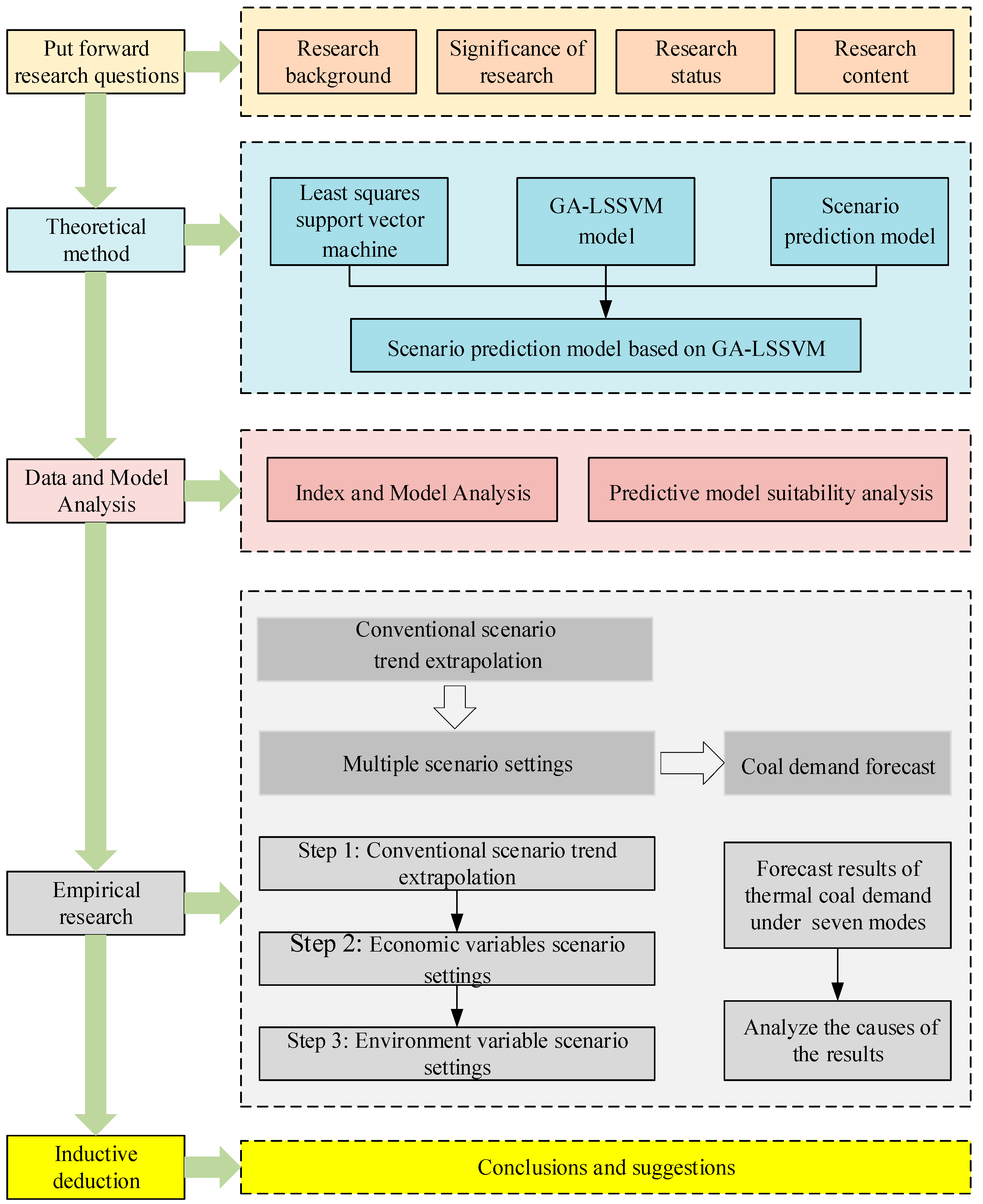
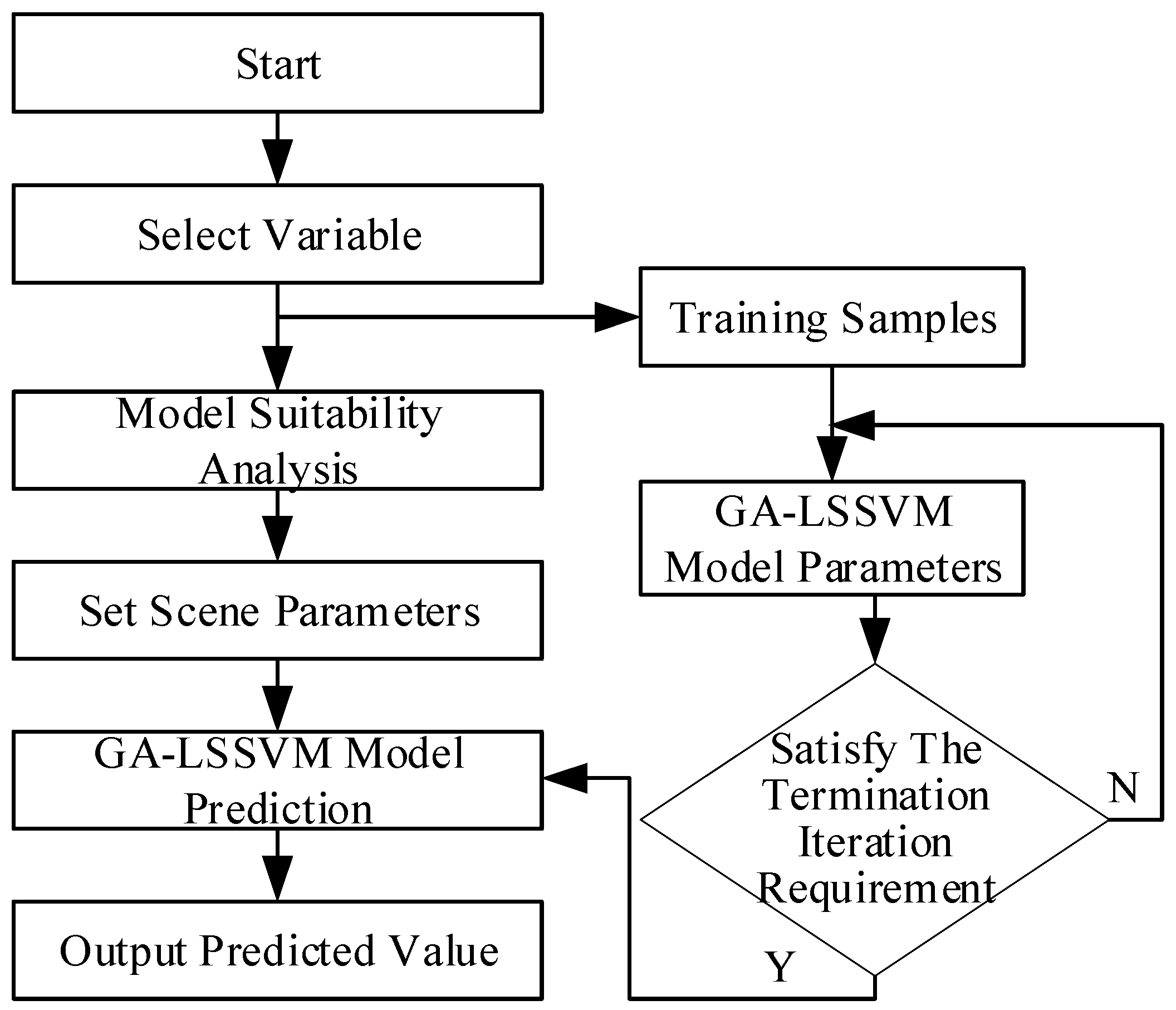
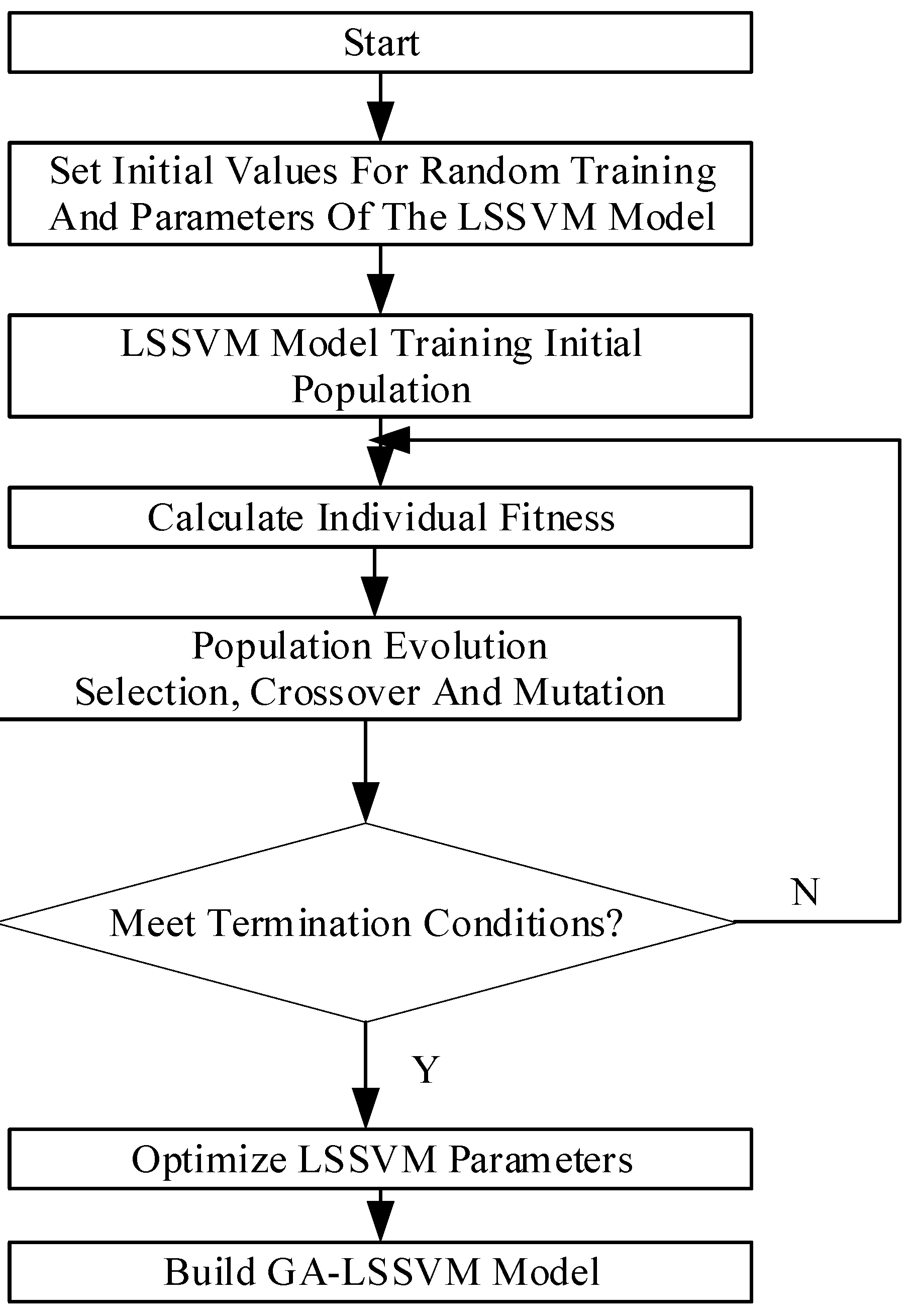
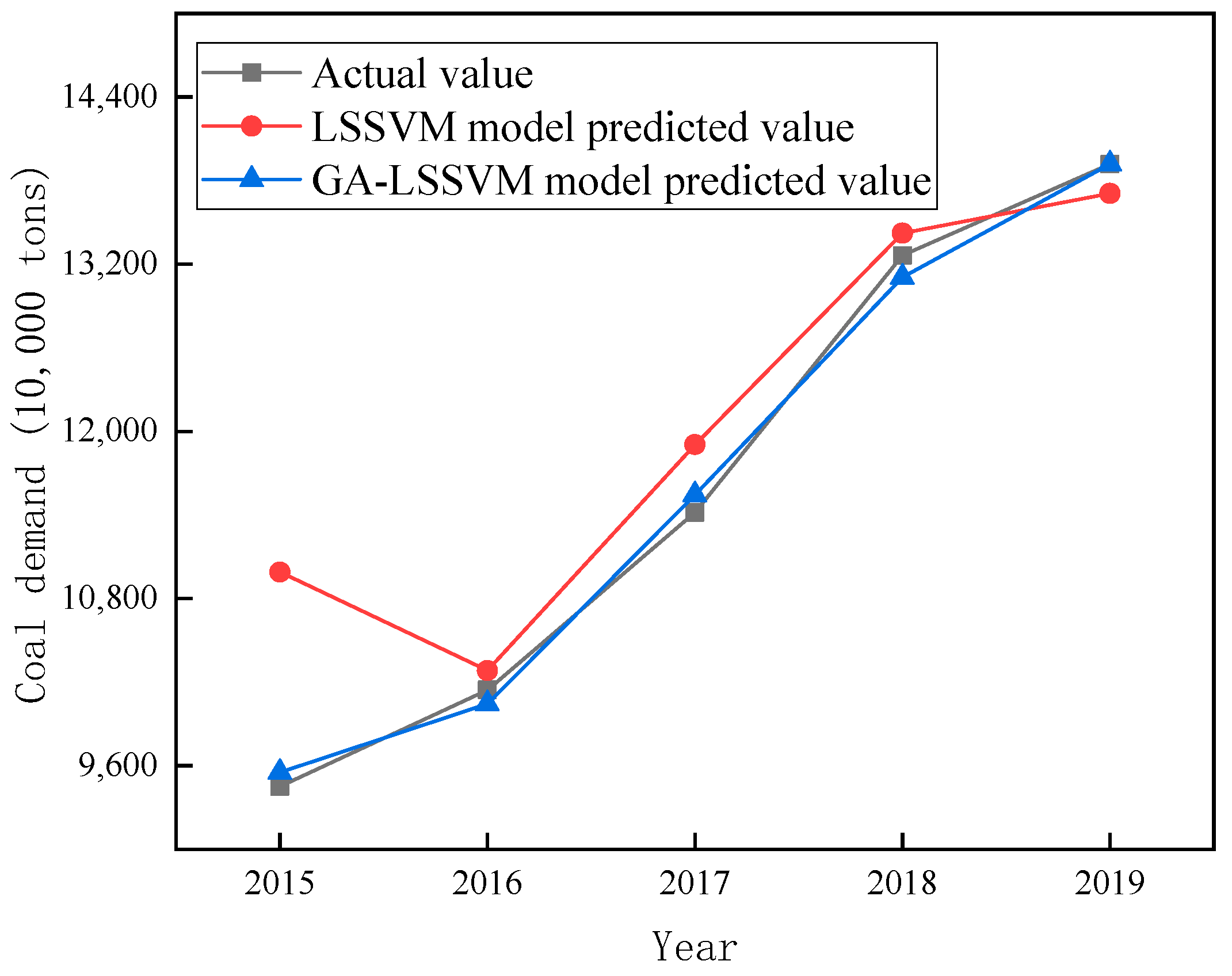

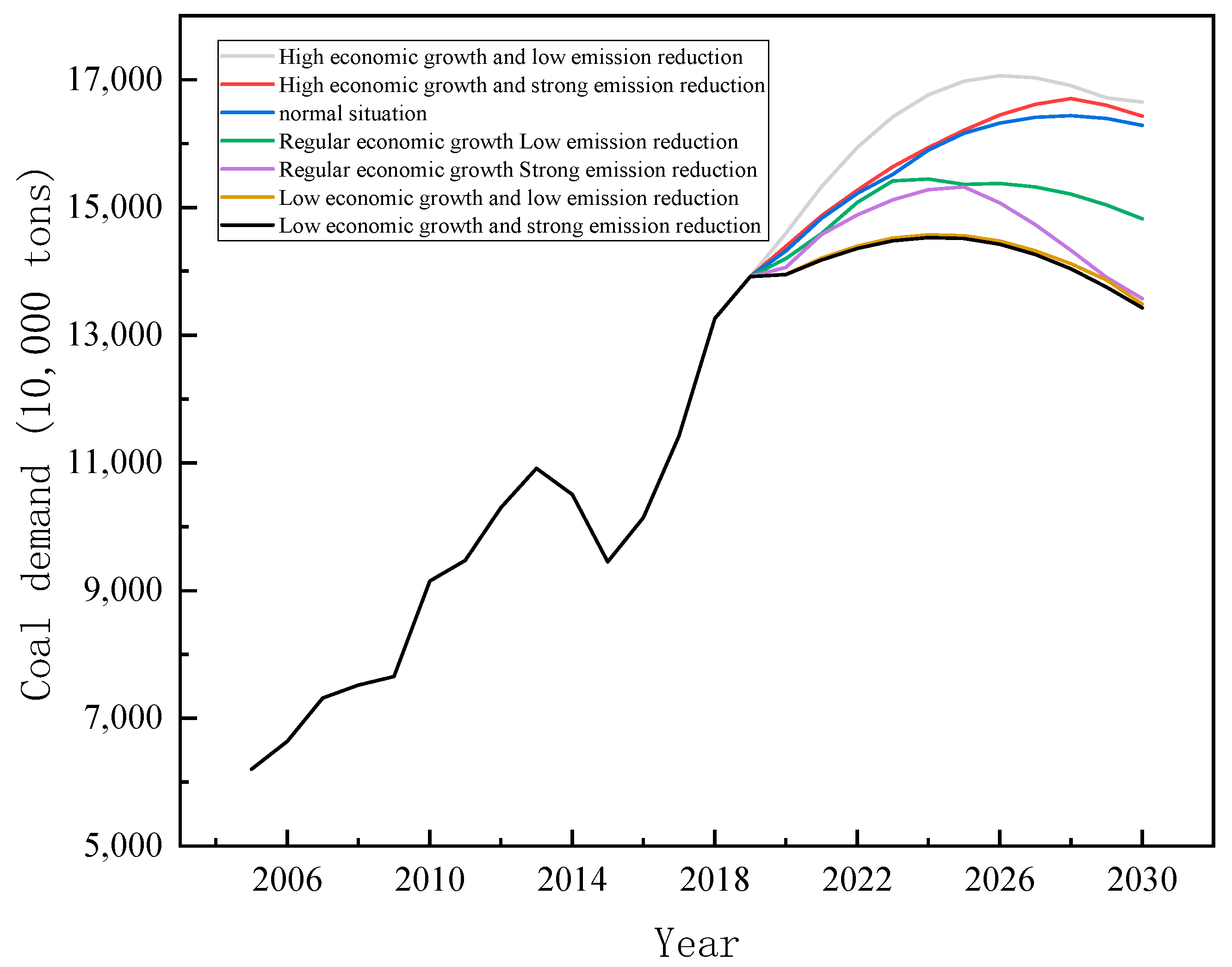
| Index | Economic Variables | Environment Variable | ||||
|---|---|---|---|---|---|---|
| GDP | Population | Urbanization Ratio | Electricity Consumption of the Whole Society | Thermal Power Installed Capacity | Carbon Emissions | |
| Pearson correlation | 0.971 ** | 0.925 ** | 0.919 ** | 0.939 ** | 0.980 ** | 0.919 ** |
| Sig. (two-tailed) | 0.000 | 0.000 | 0.000 | 0.000 | 0.000 | 0.000 |
| Evaluation Indicators | LSSVM Model | GA–LSSVM Model |
|---|---|---|
| MSE (mean squared error) | 450,121.51 | 15,107.43 |
| RMSE (root mean Square error) | 225,060.75 | 7553.72 |
| MAE (mean absolute error) | 507.10 | 96.87 |
| MAPE (mean absolute percentage error) | 4.93% | 0.87% |
| Input Variable | R Square | Constant | First-Order Coefficient | Quadratic Coefficient |
|---|---|---|---|---|
| GDP | 0.970 | 2857.100 | 1156.200 | −15.022 |
| Population | 0.957 | 3271.200 | 51.139 | −1.366 |
| Urbanization ratio | 0.996 | 0.401 | 0.014 | −0.00005 |
| Electricity consumption of the whole society | 0.934 | 916.410 | 101.820 | −1.219 |
| Thermal power installed capacity | 0.998 | 1724.600 | 487.510 | −9.959 |
| Carbon emissions | 0.972 | 55,662.000 | 1358.300 | 146.450 |
| Year | High Economic Growth Model | Normal Economic Growth | Low Economic Growth | |||||||||
|---|---|---|---|---|---|---|---|---|---|---|---|---|
| G/% | P/% | U/% | E/% | G/% | P/% | U/% | E/% | G/% | P/% | U/% | E/% | |
| 2020 | 4.84 | 1.29 | 3.55 | −0.26 | 2.84 | 0.29 | 2.55 | −1.26 | 0.84 | −0.71 | 1.55 | −2.26 |
| 2021 | 5.77 | 1.16 | 3.01 | 3.76 | 3.77 | 0.16 | 2.01 | 2.76 | 1.77 | −0.84 | 1.01 | 1.76 |
| 2022 | 5.47 | 1.09 | 2.95 | 3.58 | 3.47 | 0.09 | 1.95 | 2.58 | 1.47 | −0.91 | 0.95 | 1.58 |
| 2023 | 5.19 | 1.02 | 2.90 | 3.41 | 3.19 | 0.02 | 1.90 | 2.41 | 1.19 | −0.98 | 0.90 | 1.41 |
| 2024 | 4.94 | 0.94 | 2.85 | 3.25 | 2.94 | −0.06 | 1.85 | 2.25 | 0.94 | −1.06 | 0.85 | 1.25 |
| 2025 | 4.71 | 0.87 | 2.80 | 3.10 | 2.71 | −0.13 | 1.80 | 2.10 | 0.71 | −1.13 | 0.80 | 1.10 |
| 2026 | 4.49 | 0.80 | 2.75 | 2.96 | 2.49 | −0.20 | 1.75 | 1.96 | 0.49 | −1.20 | 0.75 | 0.96 |
| 2027 | 4.28 | 0.72 | 2.71 | 2.83 | 2.28 | −0.28 | 1.71 | 1.83 | 0.28 | −1.28 | 0.71 | 0.83 |
| 2028 | 4.09 | 0.65 | 2.66 | 2.70 | 2.09 | −0.35 | 1.66 | 1.70 | 0.09 | −1.35 | 0.66 | 0.70 |
| 2029 | 3.91 | 0.58 | 2.62 | 2.58 | 1.91 | −0.42 | 1.62 | 1.58 | −0.09 | −1.42 | 0.62 | 0.58 |
| 2030 | 3.74 | 0.50 | 2.58 | 2.47 | 1.74 | −0.50 | 1.58 | 1.47 | −0.26 | −1.50 | 0.58 | 0.47 |
| Average Growth Rate | 4.68 | 0.87 | 2.85 | 2.76 | 2.68 | −0.13 | 1.85 | 1.76 | 0.68 | −1.13 | 0.85 | 0.76 |
| Year | Normal Development Model | Low Emission Reduction Mode | Strong Emission Reduction Mode | |||
|---|---|---|---|---|---|---|
| T/% | C/% | T/% | C/% | T/% | C/% | |
| 2020 | 4.31 | 4.31 | 1.31 | 0.24 | −0.69 | −4.76 |
| 2021 | 2.28 | 2.28 | −0.72 | 0.39 | −2.72% | −4.61 |
| 2022 | 1.95 | 1.95 | −1.05 | 0.36 | −3.05 | −4.64 |
| 2023 | 1.64 | 1.64 | −1.36 | 0.31 | −3.36 | −4.69 |
| 2024 | 1.34 | 1.34 | −1.66 | 0.26 | −3.66 | −4.74 |
| 2025 | 1.06 | 1.06 | −1.94 | 0.21 | −3.94 | −4.79 |
| 2026 | 0.78 | 0.78 | −2.22 | 0.15 | −4.22 | −4.85 |
| 2027 | 0.52 | 0.52 | −2.48 | 0.08 | −4.48 | −4.92 |
| 2028 | 0.25 | 0.25 | −2.75 | 0.01 | −4.75 | −4.99 |
| 2029 | −0.01 | −0.01 | −3.01 | −0.06 | −5.01 | −5.06 |
| 2030 | −0.27 | −0.27 | −3.27 | −0.13 | −5.27 | −5.13 |
| Average Growth Rate | 1.26 | 1.26 | −1.74 | 0.17 | −0.69 | −4.76 |
Publisher’s Note: MDPI stays neutral with regard to jurisdictional claims in published maps and institutional affiliations. |
© 2022 by the authors. Licensee MDPI, Basel, Switzerland. This article is an open access article distributed under the terms and conditions of the Creative Commons Attribution (CC BY) license (https://creativecommons.org/licenses/by/4.0/).
Share and Cite
Liu, Y.; Du, R.; Niu, D. Forecast of Coal Demand in Shanxi Province Based on GA—LSSVM under Multiple Scenarios. Energies 2022, 15, 6475. https://doi.org/10.3390/en15176475
Liu Y, Du R, Niu D. Forecast of Coal Demand in Shanxi Province Based on GA—LSSVM under Multiple Scenarios. Energies. 2022; 15(17):6475. https://doi.org/10.3390/en15176475
Chicago/Turabian StyleLiu, Yujing, Ruoyun Du, and Dongxiao Niu. 2022. "Forecast of Coal Demand in Shanxi Province Based on GA—LSSVM under Multiple Scenarios" Energies 15, no. 17: 6475. https://doi.org/10.3390/en15176475
APA StyleLiu, Y., Du, R., & Niu, D. (2022). Forecast of Coal Demand in Shanxi Province Based on GA—LSSVM under Multiple Scenarios. Energies, 15(17), 6475. https://doi.org/10.3390/en15176475






